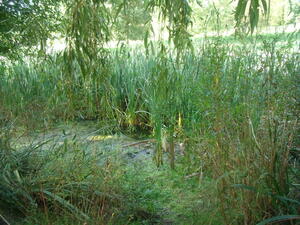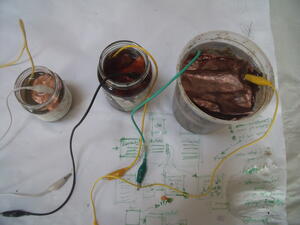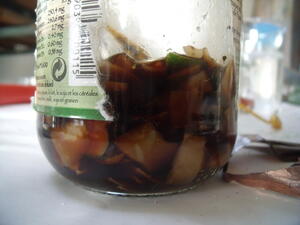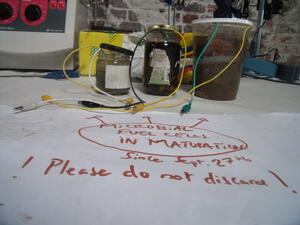Table of Contents
Experiment "Bruxelles2"
Salt Bridges
I tried three batches of salt bridges before managing to have a stable one made.
The right protocol:
- Mix 200 ml water, 5 g of agar and 75g of salt in a cooking pan.
- Bring it to a boil while mixing regularly.
- Let it boil for a few minutes (not too much, otherwise you will loose your water)
- Pour the boiling mix in appropriate containers
- Reused glass jars (with an opening having a size close to the widest diameter of the pot)
- Glass petri dishes
- Let them cool down a bit
- Place them in the fridge for a few hours
What not to do:
- Use hot water from a kettle and mix everything in a cold pot
- This induces a very uneven mix, where salt and agar are not well dissolved
- Let it sit in the pot beore pouring it on top of the substrate
- Warm liquid may harm the microbes in the substrate
- Most of the agar and salt will sediment at the bottom of the pot, and your mix will not become a gelatin
- Do not forget that the fridge step is important !
- I highly suspect gelatin to be inefficient for this process. My successful batch was made from agar-agar from a chemical provider. I think other sources may be fine, but I have not managed to use them properly yet.
Mud, Tall
 Mud samping location - Sint-Jans-Molenbeek, Belgium
Mud samping location - Sint-Jans-Molenbeek, Belgium
Design details:
- The mud sample was taken from the waterland at the bottom of Scheutbos Park in Sint-Jans-Molenbeek.
- Its approximate volume is 50 cl.
- On top is a highly concentrated Petri-dish-sized salt bridge.
- On top is filtered water.
- Electrodes are made of copper from dead batteries. They have an approximate surface area of 100cm2 each.
- Crocodile clips are clipped on the electrodes and brought out of the pot for measurement.
Results:
- Tension is unsensitive to oxygen presence, and is in the 300mV range.
- Current is in the 1-2mA range.
- Power is therefore in the mW range.
Longer-term results (12 days & more):
- Tension is stable at 110 mV, but drops when measuring current (and rises up afterwards).
- Current is stable at 107 microA, but drops after measuring tension (and rises up afterwards).
- Overall power is therefore around 11 mW.
Mud, Small
Design details:
- The mud sample was taken from the waterland at the bottom of Scheutbos Park in Sint-Jans-Molenbeek.
- Its approximate volume is 3 cl.
- On top is a salt bridge the size of the jar.
- On top is filtered water.
- Electrodes are made of copper from dead batteries. They have an approximate surface area of 10-20cm2 each.
- Crocodile clips are clipped on the electrodes and brought out of the pot for measurement.
Results:
- Tension is sensitive to oxygen presence, and is in the 100mV range when activated, 30 mV at rest.
- Current is sensitive to oxygen presence, and is very low - about 0.3 mV when activated, dropping to 0.1 mV at rest.
- Power is therefore in the microW range.
Longer-term results (12 days & more):
- Tension is stable at 20 mV.
- Current is stable at 1 microA.
- Overall power is therefore around 20 microW.
Vegetable Waste & Compost Tea
Design details:
- The substrate is made of vegetable scraps (potatoes, carrotes, zucchinis) covered with compost tea (from FoAM's vermicompost production), and inoculated with a tea spoon of mud from Scheutbos Park.
- Its approximate volume is 7 cl.
- On top is a salt bridge the size of the jar (broken during the manipulations).
- On top is filtered water, which was quickly populated by compost tea from below the salt bridge.
- Electrodes are made of copper from dead batteries. They have an approximate surface area of 10-20cm2 each.
- Crocodile clips are clipped on the electrodes and brought out of the pot for measurement.
Results:
- Tension is sensitive to oxygen presence, and is in the 200mV range when activated, 80 mV at rest.
- Current is sensitive to oxygen presence, and is very low - about 0.4 mV when activated, dropping to 0.1 mV at rest.
- Power is therefore in the microW range.
Longer-term results (12 days & more):
- Tension is stable at 120 mV.
- Current is stable at 135 microA.
- Overall power is therefore around 16 mW.
Conclusion
- Electrode surface area seems an important feature.
- Most of the mud in the Tall-Mud design has been sitting here for a week, which may have an influence on community development.
- Considering electrode area and overall volume, the compost tea design seems very productive.



